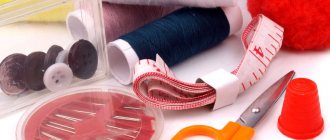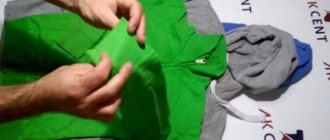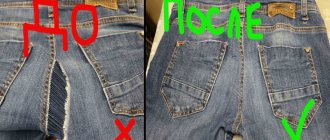Any hole, even in a visible place, can be sewn up or disguised so that nothing will be noticeable. A small tear (for example, from a cat's claw) is closed as if it were not with a hidden seam. You won't be able to sew up a large hole; decorative tricks will come to the rescue. Luckily, embroidery, patches and studs are back in fashion.
Additional tips and tricks
If the damage cannot be repaired on your own, and you do not want to contact a repair shop, it is advisable to use useful recommendations.
An elegant T-shirt can be decorated with decorative elements - brooches, rhinestones, feathers, sequins or beads. This method allows you to perfectly disguise a hole in a T-shirt and does not require any skills. After mending the hole, you need to fix the sticker, following the instructions. All you need for this is an iron and gauze. Images on thermal stickers are resistant to hand and machine washing, as well as to external influences.
Share link:
How to sew a leather jacket along the seams?
How to seal a cut on a leather jacket
- Open the lining fabric and find the cut location.
- Cut the patch to the desired size (1–1.5 larger than the size of the cut).
- It is necessary to degrease the surface.
- Apply glue to the area around the edge of the cut.
- Apply glue to the surface of the scrap.
- According to the instructions, wait time.
Interesting materials:
How to ask questions correctly in Russian? How does the change of day and night occur in Russian? How does the Unified State Examination appeal in the Russian language proceed? How to learn Latin on your own? How are foreign surnames declined in Russian? How are Ukrainian surnames declined in Russian? How to change the cyberpunk language? How to change the language in Alipay? How to change language in Skyrim? How to change the language in Snapchat?
What to do if you can’t sew up a damaged item
The best option is to take the damaged item to the studio and entrust the complex work to professionals. Sometimes even a seamstress will not be able to perfectly complete a clothing repair order, but you should not despair. Which exit?
You can save money and fix the situation yourself:
- For the restoration of knitwear, you can purchase iron-on adhesives at any “Fabric” or “Everything for Sewing” store. It is enough to transfer the decor to the material - and you can forget about the hole. In the absence of haste and selection of the optimal picture, the item often looks more impressive than before restoration;
- First you need to mend the hole, then fix the iron-on adhesive according to the instructions. For such work you do not need tailoring experience: the operation is simple, you will need an iron and gauze;
- It’s convenient that you can choose a thermal image of various sizes to decorate a damaged area on a T-shirt or other item;
- When properly fixed, the picture holds well and can withstand hand and machine washing. When removing dirt, you need to act carefully - and the item will last for a long time after restoration.
A smart T-shirt, blouse or dress can be decorated with a brooch created around a mended hole. There are a lot of options. You can use beads, sequins, feathers, shiny threads, pebbles of different sizes, unusual buttons
It is important to coordinate the new decor with other types of decorations on things, so that after restoration the product does not turn out to be cluttered and tasteless
Defects in clothing are a problem that mothers of active children often face. Anyone can accidentally tear a knitted or knitted item. It is necessary to remember about the larvae of lepidopteran butterflies that feed on the fibers of natural materials, and to prevent moths from settling in the home. If there is a hole in the clothing or a longitudinal tear, you will have to remember your labor lessons at school and carefully mend the product.
If you lack the desire, have poor eyesight, or have poor needle handling skills, you can turn to professionals from the studio for help. If you cannot sew up a T-shirt so that it is not visible, then you can easily decorate the torn product (after preliminary darning) using iron-on adhesives or appliqués made of various materials.
Useful tips on how to sew up a hole in a T-shirt with an invisible seam:
How to beautifully sew up a hole in thick fabric
It is not necessary to mask scuffs and rips on furniture, leather clothing, and denim. If they are located in a visible place, they can be decorated. Here are a few techniques:
- “leaf”: the upper and lower edges of the hole are fixed with 1 stitch, then from edge to edge of the drawn leaf, stitches are placed crosswise and tightly to each other (each goes in a house and from bottom to top), so that a braid is formed, reminiscent of the texture of a hazel leaf;
- “chain”: “sleepers” of stitches are laid from bottom to top, and then braided (the needle alternately passes under the “sleepers” from bottom to top and vice versa);
- “snowflake”: the hole is fixed from the inside with interlining or “cobweb”, the vertices of the 6-gon are marked along the face, the thread is pulled to any vertex (1), and then each time it passes from the 3rd vertex to the 2nd. And so - in a circle, decreasing the radius on each new row.
With a little skill, getting rid of small defects on clothes will not be difficult. You can remove a hole not only with a neat seam, but, for example, hide it under an applique or patterned darning, thereby beautifully decorating the item.
How to hide a hole under a zipper
If the hole is located in a visible place, then it is better to disguise it. The ideal option in many cases is zipper. Algorithm of actions:
- Place a zipper over the hole. Note the principle of placement of a decorative element.
- Apply textile glue to the reverse side of the zipper.
- Glue the workpiece to the fabric base.
- Remove excess glue with a damp cloth.
- Iron the area through the gauze.
Thus, it is possible to close the defect on any type of fabric.
Zipper to hide holes in clothes
If there is a hole in your clothing, it can be fixed. There are many options for restoring an attractive appearance to things
It is important to choose the right technique according to the type of fabric. A variety of additional materials and tools can be used
Preparing for work
Everyone always has a needle and at least three threads of primary colors: black, white and red. In order to sew up a hole really neatly, you must learn how to sew up a frayed element on clothing aesthetically, beautifully and without visible seams. Of course, it is difficult to deal with large holes, trying to make them completely unnoticeable, but if you try, you should definitely be able to sew them up efficiently.
An important point is the fabric from which the product is made.
Before sewing, first pay attention to the size of the hole, the edges, and how frayed this area of the clothing is.
Beautiful patches
If a small hole is easy to eliminate using ordinary methods, then with a large defect you will have to use your creative abilities. The easiest way to carry out repairs is with thermal stickers. They are sold at any craft store.
Various decorative stickers are selected according to the style of clothing. By the way, this way you can not only mask damage, but also create original clothes. For children's dresses there are patches with hearts, for boys' T-shirts and pants - with images of cartoon characters.
Bursting upholstery on a sofa or chair seat is also masked with patches. You won’t be able to sew up holes on the thinnest tulle unnoticed, but thermal stickers with floral patterns, butterflies, etc. will come to the rescue.
Do not rush to get rid of the product if its defect can be repaired. A neat stitch or a beautiful appliqué will bring the item back into service.
All things wear out sooner or later, but don’t immediately throw away clothes that have a hole in them. If you carefully repair a thing, it can serve you for a long time. Repairing torn clothing can save money and prevent overconsumption. There are several simple ways to sew up a hole, how to quickly breathe a second life into an item so that it sparkles with new colors in your wardrobe.
Hole on lace and guipure
Restoring torn guipure or lace is a painstaking task that requires special patience, and in most cases also experience in lace weaving. Repairing a lace product will make it easier to pre-align the edges of the hole to avoid mesh breaks.
If the hole is not noticeable, you should try to find a matching guipure pattern in stores and hem it with a thin single thread from the bottom.
You can try to restore the lace mesh pattern so that the seam from the patch is not visible. A rougher finish will be obtained by crocheting the mesh. To do this, a strong thread will need to be tied into small bundles. The most accurate restoration of the pattern is achieved when weaving lace using bobbins - special spools onto which yarn is thrown.
Some useful tips
It is worth listening to the advice of experienced housewives:
- Be sure to turn the item inside out when you plan to sew it up. The front side of the item must be made perfectly, with invisible seams and knots.
- A seam ripper will be a great help when removing unnecessary stitches.
- Store needles correctly. They should be stuck into a pad or paper.
- Try to work on your own mistakes, because the first attempt may not always be successful.
- The thread should always be matched.
- Be sure to finish the work with the correct stitches, because if you leave the thread and do not fix it in any way at the end, the seam will simply fall apart.
If you are very worried and afraid to sew up the item yourself, then it is better to contact a tailor shop that will readily solve all problems with torn clothing.
Sooner or later, there is a need for knowledge on how to mend a hole in a fabric without being noticed. There are many different techniques that are applicable to fabrics of a certain type, texture and texture.
Hole in nylon tights
Nylon is a light and fragile material that breaks at almost any snag. If you don’t have the time and money to buy a new pair, you can get used to it and carefully sew up the tights both on your fingers and in a visible place:
- Prepare a thin needle and thread that is as close in color to the product as possible. Silk threads or thread pulled from unnecessary tights are also suitable.
- Gently pinch the opposite edges at the base of the hole.
- Sew tights, sequentially picking up loops from different sides. Try not to miss a single one to prevent the material from spreading further.
- If possible, go over the seam with a clear varnish.
Advice: Don’t rush to throw away tights with a long crease. Use them to pull out thin threads and make the most invisible seams.
How to fix a round hole
The problem often appears on knitted and knitted items if moths have settled in the apartment. Holes of different sizes are quite difficult to mend: the edges are uneven, fluff hangs, and there is no clear contour for processing. What to do? Be patient, take a needle and thread of a suitable color, follow the advice. It is more convenient to darn if you place a regular electric light bulb under the torn part of the product.
How to proceed:
carefully remove torn particles of fibers from the edges of the hole; you can thread not only a thread of the same color as the material, but also a transparent nylon thread; you will have to sew each loop with neat stitches, moving in a circle; at the end of the operation, carefully tighten the thread in the central part so that the sewn area decreases, secure the edge of the thread well from the inside; All that remains is to smooth out the product; on T-shirts with a pattern or fine pile, it is easier to sew up a tear; if the darning area clearly stands out, then you will have to decorate the product taking into account the style, shade of the material, style using iron-on stickers or appliqués.
Hole on genuine leather
Although leather clothing is practical and durable, even it is not protected from accidental snags on sharp objects. Light damage - holes and narrow cuts - is best fixed with glue to an internal patch made of plaster or any thin, elastic material.
To sew up a large hole, prepare two patches to match the color of the product:
- fabric, slightly wider than the gust, will be located on the inside as a lining;
- leather, identical in size.
Next, the edges of the tear are aligned, and the patches are carefully attached to the hole, joining together.
Blind seam
You can create a beautiful and neat seam that will connect, for example, tears in a jacket, by using threads of any color and a regular needle. Thanks to a unique stitch formation technique, the seam is hidden in the fold.
Life hack on how to form a blind seam:
- Thread a thread of any color into a needle. Tie a knot at the end of the thread to secure it to the fabric.
- Assemble the hole so that the edges meet evenly at the break points. A little fabric needs to be folded to the wrong side.
- Thread the needle from the wrong side and bring the tool out at the edge of the hole.
- Thread the second part of the hole into the fabric at the same level. The needle will come out from the wrong side.
- Form a small stitch along the line along the gap and bring the needle to the front side.
- Again, thread the needle through the edge of the opposite side of the fabric of the hole, bringing it to the wrong side.
- Now all stages of work will be repeated until the entire space is stitched with such stitches.
- Tighten the thread to hide the stitches in the folds of the seam fabric.
Additional Information! This is important when sewing up seams that have come apart. On a flat surface, you should not sew up holes in this way - the fabric will be distorted or pulled.
Forming a blind seam
Using this seam option, you can repair holes in the seams of any fabric. This way, a shirt, jacket, jacket or any other item will look like new.
As for sewing up holes in knitwear, here you can also use a blind seam, but with a slightly different configuration:
- Straighten the loops together.
- Thread loops onto toothpicks on both sides.
- Using a needle and thread, prying the loops from each toothpick, tighten the fabric.
Seam closure on knitwear using a blind seam
Usually, knitted items are sewn together in this way, but chunky knitwear is also sewn together in the same way. Therefore, a torn T-shirt made of good jersey can be saved by using this type of stitching.
Hole on hand knitwear
A suitable repair method for knitted items is darning. How discreetly you can hide the loose loops depends on the size of the damage. Thus, a short hook with a torn or pulled out thread can easily be patched with a knitted seam, simply by gathering the loops together with a suitable thread.
If the thread breaks and the fabric unravels, the best option is to restore the torn thread in the top row (by tying the ends) or replace it with a new one, then arm yourself with knitting needles or a crochet hook and pick up the thread, re-knitting the section. Secure with a “crawfish step” or a simple overlock stitch.
How to remove a large tear if all or several threads are torn:
- Use a needle-forward stitch around the tear. This way the fabric will not stretch during darning, and the thread can be pulled out afterwards.
- Then, between the outer loops of each row of holes, stretch thin transverse threads as a base.
- Perform the darning itself by wrapping loops around each warp thread from the top to the very bottom of the break. Next row, “braid” the hole with the same girths, but from the bottom up.











